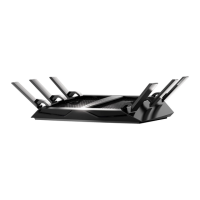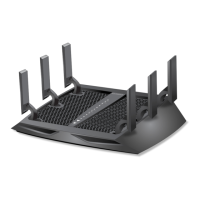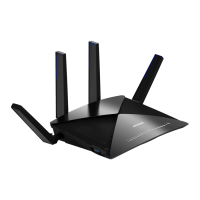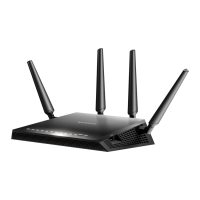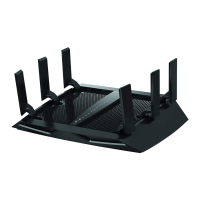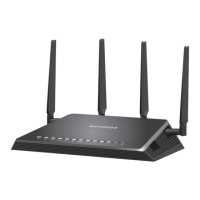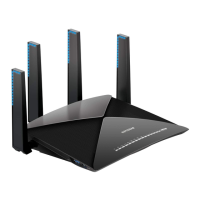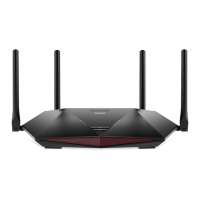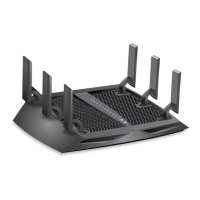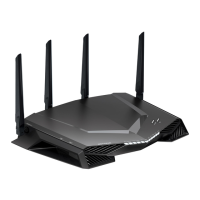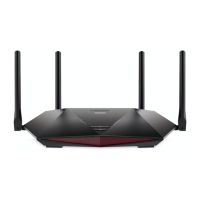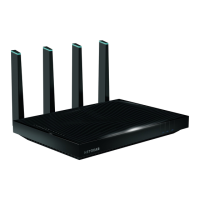Do you have a question about the NETGEAR Nighthawk X6 AC3200 and is the answer not in the manual?
Steps to access and configure the router's interface using a web browser.
How to log in to the router's web interface using default admin credentials.
Guided setup process to automatically detect and configure internet connection settings.
Manual configuration of internet connection settings, including IP, DNS, and MAC address.
Configuring parental controls to filter internet content and manage user access.
Explanation of tri-band WiFi technology and its benefits for speed and performance.
How Smart Connect intelligently assigns devices to the optimal WiFi band for performance.
Connecting to and sharing USB devices connected to the router over the local network.
Accessing connected USB devices via the internet when away from home.
Configuring FTP access for USB devices to allow file transfer over the internet.
Using Dynamic DNS to access the home network and router via a domain name.
Setting up a personal FTP server using the router and Dynamic DNS for remote access.
Connecting to and printing using a shared USB printer via the utility.
Modifying the router's LAN IP address, subnet mask, and other TCP/IP settings.
Configuring fundamental wireless settings like SSID, security, and channel.
Modifying the WiFi network password and security level (WPA2/WPA).
Creating a separate guest WiFi network for visitors, isolating them from the main network.
Checking for and installing the latest firmware updates for the router.
Changing the administrator password for accessing the router's settings.
Steps to recover the router's admin password if it is forgotten.
Verifying the router's current internet connection status and IP configuration.
Enabling and configuring remote management to access router settings over the internet.
Establishing a secure virtual private network (VPN) tunnel for remote access.
Configuring VPN service parameters within the router, such as service type and port.
Installing the OpenVPN client software on computers for VPN connections.
Using a VPN to access your home internet service when away from home.
Configuring port forwarding rules to allow specific incoming traffic to reach local servers.
Configuring port triggering for dynamic opening of ports based on outbound traffic.
Diagnosing router issues by interpreting the status of various LED indicators.
Resolving problems with logging into the router or accessing the internet.
Isolating and resolving issues related to wireless device connectivity.
Steps to access and configure the router's interface using a web browser.
How to log in to the router's web interface using default admin credentials.
Guided setup process to automatically detect and configure internet connection settings.
Manual configuration of internet connection settings, including IP, DNS, and MAC address.
Configuring parental controls to filter internet content and manage user access.
Explanation of tri-band WiFi technology and its benefits for speed and performance.
How Smart Connect intelligently assigns devices to the optimal WiFi band for performance.
Connecting to and sharing USB devices connected to the router over the local network.
Accessing connected USB devices via the internet when away from home.
Configuring FTP access for USB devices to allow file transfer over the internet.
Using Dynamic DNS to access the home network and router via a domain name.
Setting up a personal FTP server using the router and Dynamic DNS for remote access.
Connecting to and printing using a shared USB printer via the utility.
Modifying the router's LAN IP address, subnet mask, and other TCP/IP settings.
Configuring fundamental wireless settings like SSID, security, and channel.
Modifying the WiFi network password and security level (WPA2/WPA).
Creating a separate guest WiFi network for visitors, isolating them from the main network.
Checking for and installing the latest firmware updates for the router.
Changing the administrator password for accessing the router's settings.
Steps to recover the router's admin password if it is forgotten.
Verifying the router's current internet connection status and IP configuration.
Enabling and configuring remote management to access router settings over the internet.
Establishing a secure virtual private network (VPN) tunnel for remote access.
Configuring VPN service parameters within the router, such as service type and port.
Installing the OpenVPN client software on computers for VPN connections.
Using a VPN to access your home internet service when away from home.
Configuring port forwarding rules to allow specific incoming traffic to reach local servers.
Configuring port triggering for dynamic opening of ports based on outbound traffic.
Diagnosing router issues by interpreting the status of various LED indicators.
Resolving problems with logging into the router or accessing the internet.
Isolating and resolving issues related to wireless device connectivity.
| WiFi Range | Very large homes |
|---|---|
| Beamforming | Yes |
| Wireless Standard | 802.11 a/b/g/n/ac |
| Smart Connect | Yes |
| Security | WPA/WPA2-PSK |
| Parental Controls | Yes |
| Quality of Service (QoS) | Yes |
| WiFi Speed | 3200 Mbps |
| Ethernet Ports | 5 x 10/100/1000 Mbps Gigabit Ethernet ports |
| USB Ports | 1 USB 3.0 & 1 USB 2.0 |
| Processor | Dual Core Processor |
| Memory | 128MB Flash, 256MB RAM |
| Antenna | 6 high-performance antennas |
| Frequency Band | 2.4GHz, 5GHz |
| WiFi Technology | Tri-Band |
| Weight | 2.43 lb (1.10 kg) |
